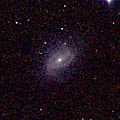astro.wikisort.org - Galaxy
NGC 1187 is a barred spiral galaxy located about 60 million light-years away in the constellation of Eridanus. It was discovered on December 9, 1784 by the astronomer William Herschel.[4]
| NGC 1187 | |
|---|---|
 NGC 1187 has hosted two supernova explosions during the last thirty years, the latest one in 2007.[1] | |
| Observation data (J2000 epoch) | |
| Constellation | Eridanus[1] |
| Right ascension | 03h 02m 37.40s[2] |
| Declination | −22° 52′ 02.0″[2] |
| Redshift | 0.004657[2] |
| Helio radial velocity | 1393 km/s[2] |
| Distance | 60 million ly[1] |
| Apparent magnitude (V) | 11.4[2] |
| Characteristics | |
| Type | SB(r)c[3] |
| Apparent size (V) | 5.370′ x 3.630′[2] |
| Other designations | |
| HIPASS J0302-22, MCG-04-08-016, UGCA 49, AM 0300-230, IRAS 03003-2303, NVSS J030237-225200, [CHM2007] LDC 251 J030237.58-2252017, 6dFGS gJ030237.6-225202, IRAS F03004-2303, PSCz Q03003-2303, [WDW2002] HIPASS J0302-22, DUGRS 480-001, LEDA 11479, RR95 70b, ESO 480-23, 2MASX J03023758-2252017, SGC 030024-2303.8, ESO-LV 480-0230, MBG 03004-2303, SINGG HIPASS J0302-22. | |
NGC 1187 has hosted two supernova explosions since the 1980s. In October 1982, the first supernova seen in NGC 1187 — SN 1982R, a type I,[5] was discovered at La Silla Observatory[1] and, in 2007, the amateur astronomer Berto Monard in South Africa spotted another supernova in this galaxy — SN 2007Y, a type Ib/c.[6][7]
Gallery
References
- "A Blue Whirlpool in The River". ESO Press Release. Retrieved 1 August 2012.
- "Search results for NGC 1187". Astronomical Database. SIMBAD. Retrieved 1 August 2012.
- "Results for object NGC 1187 (NGC 1187)". NASA/IPAC Extragalactic Database. California Institute of Technology. Retrieved 2021-02-21.
- Seligman, Courtney. "New General Catalogue objects: NGC 1150 - 1199". cseligman.com. Retrieved 2021-02-21.
- "SN 1982R | Transient Name Server". www.wis-tns.org. Retrieved 2021-03-13.
- Stritzinger, Maximilian; Mazzali, Paolo; Phillips, Mark M.; Immler, Stefan; Soderberg, Alicia; Sollerman, Jesper; Boldt, Luis; Braithwaite, Jonathan; Brown, Peter; Burns, Christopher R.; Contreras, Carlos; Covarrubias, Ricardo; Folatelli, Gaston; Freedman, Wendy L.; Gonzalez, Sergio; Hamuy, Mario; Krzeminski, Wojtek; Madore, Barry F.; Milne, Peter; Morrell, Nidia; Persson, S. E.; Roth, Miguel; Smith, Mathew; Suntzeff, Nicholas B. (2009). "The He-rich core-collapse supernova 2007Y: Observations from X-ray to Radio Wavelengths". The Astrophysical Journal. 696 (1): 713–728. arXiv:0902.0609. Bibcode:2009ApJ...696..713S. doi:10.1088/0004-637X/696/1/713.
- "Bright Supernovae - 2007". www.rochesterastronomy.org. Retrieved 2021-03-13.
External links
 Media related to NGC 1187 at Wikimedia Commons
Media related to NGC 1187 at Wikimedia Commons
На других языках
[de] NGC 1187
NGC 1187 ist eine Balkenspiralgalaxie vom Hubble-Typ SB(r)c im Sternbild Eridanus südlich des Himmelsäquators. Sie ist schätzungsweise 60 Millionen Lichtjahre von der Milchstraße entfernt und hat einen Scheibendurchmesser von etwa 100.000 Lj. Sie hat mit PGC 11469 eine rund 25.000 Lj durchmessende Begleitgalaxie.[3] Innerhalb der vergangenen 30 Jahre konnten Astronomen zwei Supernova-Explosion in dieser Galaxie beobachten: Im Oktober 1982 SN 1982R, im Jahr 2007 SN 2007Y.[4]- [en] NGC 1187
[ru] NGC 1187
NGC 1187 (другие обозначения — ESO 480-23, MCG −4-8-16, UGCA 49, AM 0300-230, IRAS 03003-2303, PGC 11479) — спиральная галактика с перемычкой (SBc) в созвездии Эридан к югу от небесного экватора.Текст в блоке "Читать" взят с сайта "Википедия" и доступен по лицензии Creative Commons Attribution-ShareAlike; в отдельных случаях могут действовать дополнительные условия.
Другой контент может иметь иную лицензию. Перед использованием материалов сайта WikiSort.org внимательно изучите правила лицензирования конкретных элементов наполнения сайта.
Другой контент может иметь иную лицензию. Перед использованием материалов сайта WikiSort.org внимательно изучите правила лицензирования конкретных элементов наполнения сайта.
2019-2025
WikiSort.org - проект по пересортировке и дополнению контента Википедии
WikiSort.org - проект по пересортировке и дополнению контента Википедии


